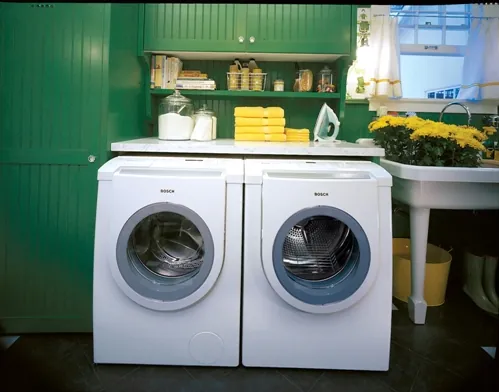Washing machines are no longer simple appliances of convenience? Today's machines must be both functional and aesthetically pleasing.
With more choices in size, settings, and even colors, the available options for properly outfitting your dream laundry room are dizzying! To begin narrowing down your selection, there are three main components to consider.
Top Loading Machine
Today's washers come in two differing styles, top and front loading. Top loading machines have long been the standard in laundry rooms. They perform with an interior wash tub that has an open basket and center agitator in which the clothes are loaded from the top and covered with a hinged door. Top loaders offer faster cycles and allow the clothes to be removed mid-cycle if needed. They are also easier to load, less expensive and more durable than their more modern counterparts. Tried and true, this style seems to be maintaining its popularity even with more technologically advanced versions coming out.

Photo courtesy of Bosch
Front Loading Machine
More energy efficient and accommodating to space constraints, front loading machines are fast becoming the newest trend in washing machines. With no center agitator, front loading stainless steel drums hold larger loads while using up to 40% less water than the average top loading washer. This high efficiency results in damp clothing rather than very wet clothing, making the drying process even faster as well. Though these machines are initially more expensive, they save in both future water and electricity costs. And while the cycle times are longer than top loading machines, the process is gentler on most fabrics.
 |
Photo courtesy of Bosch |
The Energy Guide
Protecting the environment and lowering utility bills seems to be on the forefront of everyone's minds. To best determine the energy efficiency of a machine, look for the black and gold energy guide label. This label not only advertises the forecasted energy consumption but also estimates the operating cost per year. The energy guide also allows for easy comparison between different machines by showcasing where each falls in the range of energy use. Further, washing machines that are EnergyStar?-certified can save a household more than $500 a year in operating costs, and will create less waste and pollution.
It is important to be aware of various marketing ploys. Some washers come with numerous settings and special features that may cost extra and will later be unused. Think about what kind of clothing you will be washing ? will you use a special "handwash" feature for various delicates? Or does everything get thrown into the machine? Other things to look for include:
-
Many water level settings
-
Numerous temperature options
-
Controls of time and spin cycles
-
Automatic dispensers for detergent and bleach
Also, more washing machines are being advertised as "extra large capacity" which appeal to families with large amounts of wash. However, this "extra large" label can be misleading ? it may simply be a slightly larger machine drum that does not necessarily wash more clothes as efficiently as a standard "large" washer, and its extra size may not fit into your laundry room. Keep your laundry room's measurements in mind, but begin your search by looking for the durable washing machines that are most water, time, and energy efficient for your family. Do not forget to look at warranties, service contracts, and consumer reports before purchase. As with all large appliance purchases it is important to take your time and ask questions before buying. With a little patience and a solid knowledge of what your family needs, you will be able to find the washing machine that perfectly fits your dream laundry room.
Here are some related articles:
Save this article to:
back to top